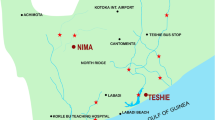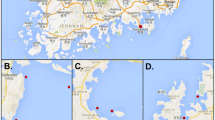Abstract
Cholera is a severe diarrheal disease caused by the consumption of food or water contaminated with the aquatic gram-negative bacterium Vibrio cholerae. Infected hosts will experience vomiting and severe watery diarrhea and if not treated properly will ultimately succumb to death by dehydration. Due to the global prevalence and severity of cholera, V. cholerae has been extensively studied in both environmental and laboratory settings. Herein, we describe proper V. cholerae maintenance, in addition to classical and El Tor biotype culturing in a laboratory setting.
Access this chapter
Tax calculation will be finalised at checkout
Purchases are for personal use only
Similar content being viewed by others
References
Loharikar A, Newton AE, Stroika S et al (2015) Cholera in the United States, 2001–2011: a reflection of patterns of global epidemiology and travel. Epidemiol Infect 143:695–703
Taylor R, Miller V, Furlong D et al (1987) Use of phoA gene fusions to identify a pilus colonization factor coordinately regulated with cholera-toxin. Proc Natl Acad Sci U S A 84:2833–2837
Herrington D, Hall R, Losonsky G et al (1988) Toxin, toxin coregulated pili, and the toxR regulon are essential for Vibrio cholerae pathogenesis in humans. J Exp Med 168:1487–1492
Karaolis D, Johnson J, Bailey C et al (1998) A Vibrio cholerae pathogenicity island associated with epidemic and pandemic strains. Proc Natl Acad Sci U S A 95:31343139
Waldor MK, Mekalanos JJ (1996) Lysogenic conversion by a filamentous phage encoding cholera toxin. Science 272:1910–1914
Kovacikova G, Skorupski KS (1999) A Vibrio cholerae LysR homolog, AphB, cooperates with AphA at the tcpPH promoter to activate expression of the ToxR virulence cascade. J Bacteriol 181:4250–4256
Kovacikova G, Skorupski KS (2001) Overlapping binding sites for the virulence gene regulators AphB and cAMP-CRP at the Vibrio cholerae tcpPH promoter. Mol Microbiol 41:393–407
Kaper J, Bradford H, Roberts N et al (1982) Molecular epidemiology of Vibrio cholerae in the U.S. Gulf Coast. J Clin Microbiol 16:129–134
Karaolis D, Lan R, Reeves P et al (1995) The sixth and seventh cholera pandemics are due to independent clones separately derived from environmental, nontoxigenic, non-O1 Vibrio cholerae. J Bacteriol 177:3191–3198
Karaolis D, Lan R, Kaper J et al (2001) Comparison of Vibrio cholerae pathogenicity islands in sixth and seventh pandemic strains. Infect Immun 69:1947–1952
Ghosh-Banerjee J, Senoh M, Takahashi T et al (2010) Cholera toxin production by the El Tor variant of Vibrio cholerae O1 compared to the prototype El Tor and classical biotypes. J Clin Microbiol 48:4283–4286
Barua D (1992) History of cholera. In: Barua D, Greenough W III (eds) Cholera. Plenum Publishing Corporation, New York, NY
Morales R, Delgado G, Cravioto A (2008) Population genetics of Vibrio cholerae. In: Faruque S, Nair G (eds) Vibrio cholerae—Genomics and molecular biology. Caister Academic Press, Norfolk
Sack D, Sack R, Nair G et al (2004) Cholera. Lancet 363:223–233
Ansaruzzaman M, Bhuyian N, Nair G, et al. The Mozambique Cholera Vaccine Demonstration Project Coordination Group (2004) Cholera in Mozambique, variant of Vibrio cholerae. Emerg Infect Dis 10:2057–2059
Ansaruzzaman M, Bhuyian N, Safa A et al (2007) Genetic diversity of El Tor strains of Vibrio cholerae O1 with hybrid traits isolated from Bangladesh and Mozambique. Int J Med Microbiol 297:443–449
Lan R, Reeves P (2002) Pandemic spread of cholera: genetic diversity and relationships within the seventh pandemic clone of Vibrio cholerae determined by amplified fragment length polymorphism. J Clin Microbiol 40:172–181
Nair G, Faruque S, Bhuiyan N et al (2002) New variants of Vibrio cholerae O1 biotype El Tor with attributes of the classical biotype from hospitalized patients with acute diarrhea in Bangladesh. J Clin Microbiol 40:3296–3299
Nair GB, Safa A, Bhuiyan NA et al (2006) Isolation of Vibrio cholerae O1 strains similar to pre-seventh pandemic El Tor strains during an outbreak of gastrointestinal disease in an island resort in Fiji. J Med Microbiol 55:1559–1562
Nair GB, Mukhopadhyay AK, Safa A et al (2008) Emerging hybrid variants of Vibrio cholerae O1. In: Faruque SM, Nair GB (eds) Vibrio cholerae—genomics and molecular biology. Horizon Scientific Press, Norwich, pp 179–190
Safa A, Bhuyian N, Nursin S et al (2006) Genetic characteristics of Matlab variants of Vibrio cholerae O1 that are hybrids between classical and El Tor biotypes. J Med Microbiol 55:1563–1569
Son M, Megli C, Kovacikova G et al (2011) Characterization of Vibrio cholerae O1 El Tor biotype variant clinical isolates from Bangladesh and Haiti, including a molecular genetic analysis of virulence genes. J Clin Microbiol 49:3739–3749
Nursin S, Khan G, Bhuiyan N, Ansaruzzaman M et al (2004) Diverse CTX phages among toxigenic Vibrio cholerae O1 and O139 strains isolated between 1994 and 2002 in an area where cholera is endemic. J Clin Microbiol 42:5854–5856
Acknowledgments
Research reported in this publication was supported by an Institutional Development Award (IDeA) from the National Institute of General Medical Sciences of the National Institutes of Health under grant number P20GM103506.
Author information
Authors and Affiliations
Corresponding author
Editor information
Editors and Affiliations
Rights and permissions
Copyright information
© 2018 Springer Science+Business Media, LLC, part of Springer Nature
About this protocol
Cite this protocol
Brumfield, K.D., Carignan, B.M., Son, M.S. (2018). Laboratory Culturing Techniques and Maintenance of Vibrio cholerae . In: Sikora, A. (eds) Vibrio Cholerae. Methods in Molecular Biology, vol 1839. Humana Press, New York, NY. https://doi.org/10.1007/978-1-4939-8685-9_1
Download citation
DOI: https://doi.org/10.1007/978-1-4939-8685-9_1
Published:
Publisher Name: Humana Press, New York, NY
Print ISBN: 978-1-4939-8684-2
Online ISBN: 978-1-4939-8685-9
eBook Packages: Springer Protocols




